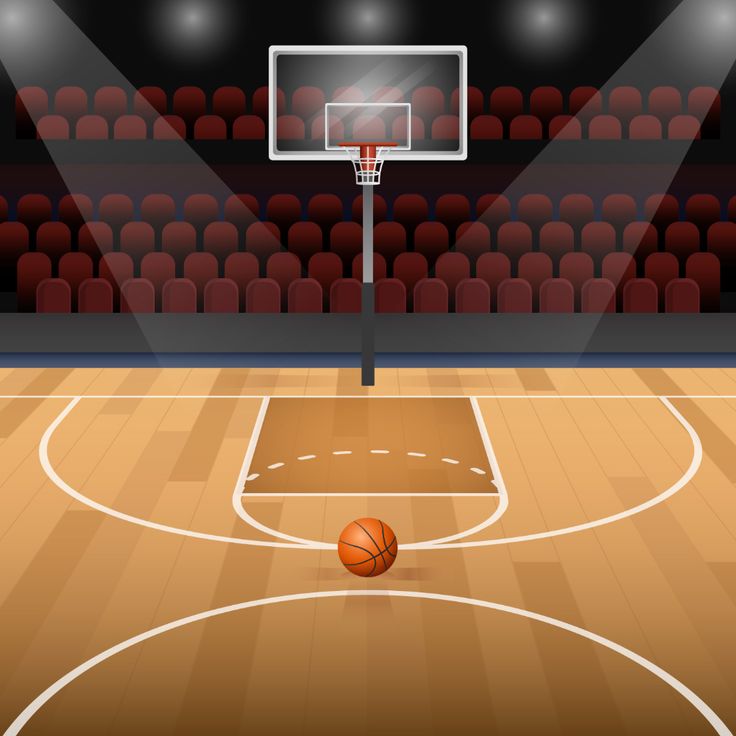Home »
Misc »
How do they paint logos on basketball courts
How do they paint logos on basketball courts
How They Do It: Pulling Off Today’s Bold Basketball Floors
Larger-than-life metallic Spartans on the new San Jose State University basketball floor created an out-of-the-box challenge for United Floor Services Inc. (Courtesy San Jose State University)
Not long ago, gym floor specialists were known mainly for their ability to travel long distances to a job, use their riding sanders to sand vast expanses of maple, paint their lines and walk miles back and forth to get finish on the floor. It wasn't a niche involving much creativity or imagination, and, except for painting the lines, it didn't require much finesse, either.
Times have changed. While coating gyms still involves a lot of walking, what happens before that final coat could hardly be called boring. Today's basketball courts are in-your-face, with huge logos and other wild graphics that are all about branding. Many people date this trend to the University of Oregon floor that debuted in 2010 (more on that in the sidebar "Into the Woods" below), with its forest of tall fir trees that broke the mold of traditional floors and even led to rule changes in the NCAA.![]()
The effects have been far-reaching. While many NBA floors remain tame in comparison, NCAA floors seem to compete to outdo each other, and high schools and even junior highs and grade schools are catching on to the trend. How do wood floor pros execute the crazy designs? HF talked to some gym floor specialists to find out.
United Services Inc.
United Services Inc. in Idaho Falls, Idaho, has a long history of doing basketball floors, but they really put themselves on the map when they created the University of Oregon floor in 2010 (see the "Into the Woods" at the end of this article). They've done many tricky designs since then, but the most elaborate one was this San Jose State University Spartans floor.
The new floor design originated with the coach, who had previously been at Boise State, known for its bold branding, including its "Smurf Turf" blue football field and its basketball floor with huge bronco heads inside the three-point lines. The coach wanted the same kind of branding for his court at San Jose State.
"They said, 'We want these Spartans faux-painted on the floor,'" United Services' General Manager Shane Matheson says. "We had to figure out what that was! On top of that they picked these metallic paints—golds, coppers, silvers—that are impossible for anything to stick to."
Once they had an image of the Spartans they liked, it was created in Adobe Illustrator. To convince the client they could actually create the design on a floor, United created an 8-foot sample. With that proof in hand and client approval, the outlines of the design were transferred to the plotter to create stencils—many, many stencils. The stencils are carefully adhered to the gym floor and have layers, so when one paint area is dry, a section can be removed and another area painted. This process can go on repeatedly depending on the complexity of the graphic.
'Countless layers' of paint and transfer paper, along with three artists, were necessary to complete the Spartans graphics on the San Jose State University basketball floor.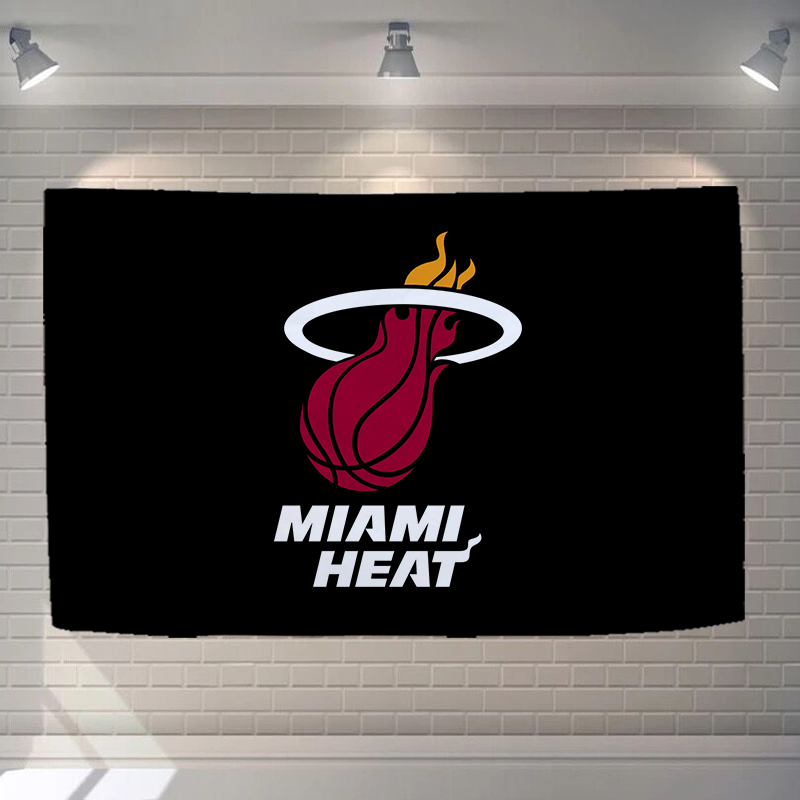
The main Spartan graphic is 27 feet tall and 48 feet wide. The first stencil created the general outline of the Spartans for the base color. At that point three artists went to work on the graphic at the same time, using stencils along with faux painting techniques. "We put the base paint layers down, pull the vinyl up, then take transfer paper—what they use on top of vinyl—and put that on top of it and cut it," Matheson explains. "It was countless layers of paint and transfer paper and cutting by hand."
The client wanted the graphic to be perfect, and the artists on the floor, including United's Project Supervisor Nathan Banks, were perfectionists, too. When the desired effects—texture of the skin, cracks in the old pounded brass armor—in some small sections didn't look right, they sanded it off and started all over again.
Because the paints were metallic, they presented particular challenges. In addition to the fact that Matheson found "not only does it look like gold, it costs like gold," due to its composition, the appearance of the paint would change depending on direction of the brush strokes.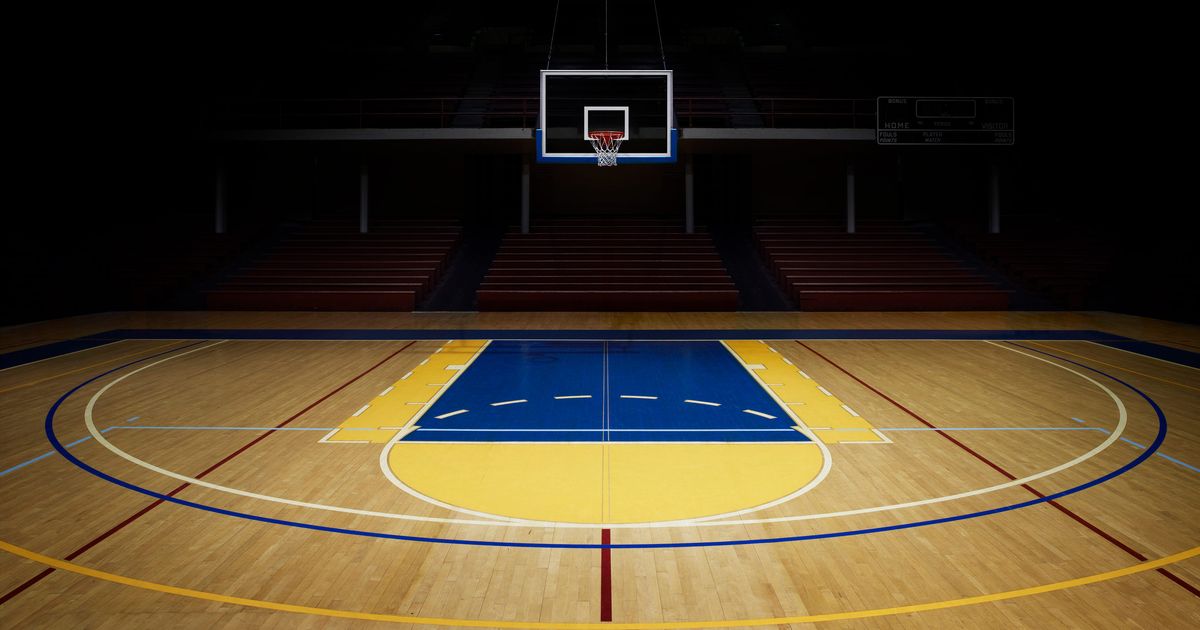 So, the crew had to airbrush the metallic paints. Sometimes one of the artists would stand on a 16-foot ladder to direct the others during airbrushing so they could be sure to get the correct overall effect. They employed stippling techniques—using small dots—and also sprayed on highlights and shadows to make the floor pop.
So, the crew had to airbrush the metallic paints. Sometimes one of the artists would stand on a 16-foot ladder to direct the others during airbrushing so they could be sure to get the correct overall effect. They employed stippling techniques—using small dots—and also sprayed on highlights and shadows to make the floor pop.
Adhesion was always on their minds, Matheson says, adding that they knew the college would be taping a volleyball court over the Spartans graphic on a regular basis, so the crew was religious about making sure each paint and finish layer would be correctly bonded.
{rblink 2331}One of the biggest challenges was hand-abrading the entire graphic, Matheson says. ("I've seen guys spend hours hand-painting a logo and then run a buffer over it and ruin it," he says.) Then a sealer with "very good adhesion characteristics" was used to coat the graphic before the buffers abraded the rest of the floor.
"If you get close to them the details are incredible. You can see sweat, patina, cracks in the armor.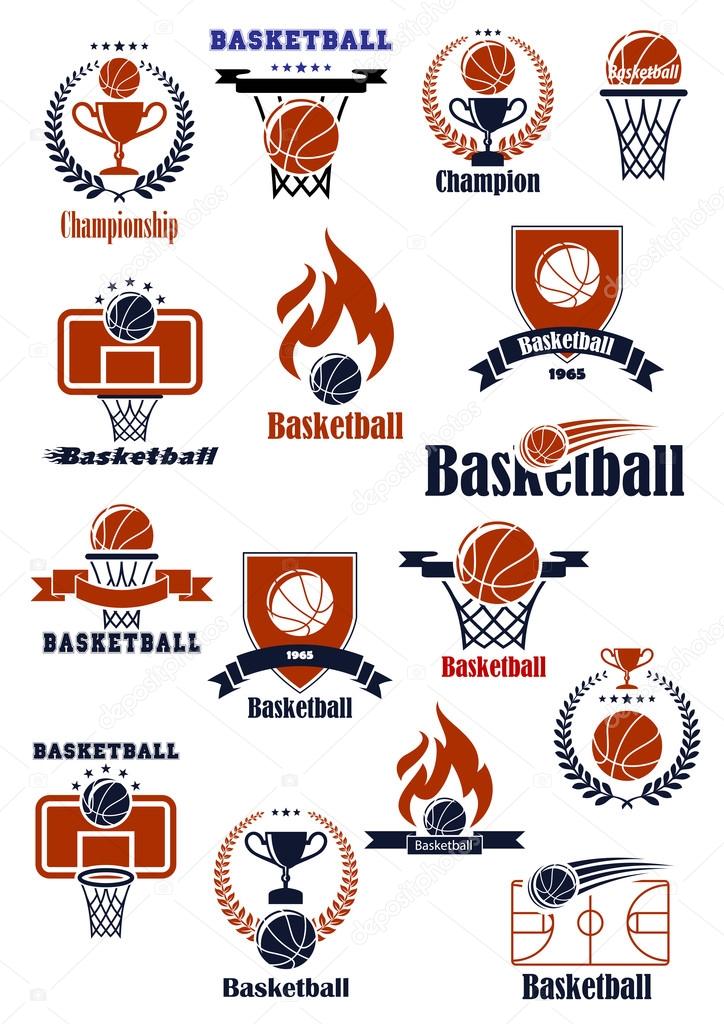 When we were done they said, 'That is so much better than our expectations,'" Matheson says.
When we were done they said, 'That is so much better than our expectations,'" Matheson says.
By comparison, the rest of the floor was easy. The large logo was painted—a routine process for them—and inside the three-point lines, the maple floor was stained. Although Matheson says the first time they ever stained a maple floor it turned out "nasty," by now they have their process—involving not sanding to too high of a grit, conditioning and water-popping the floor correctly—down to a science.
The university ships the court back to United every year to touch up and recoat, not risking damage to the floor that cost at least $250,000.
Pulling off a floor like this takes decades of accumulated experience, Matheson says. "It's a team effort to do it—all the way from the selling of it, to the design of it, to the execution and maintenance of it. It just takes a lot of people to do this, and everything has to fall in line."
Worst Mistake: "When the Seattle SuperSonics moved to be the Oklahoma City Thunder, it was an elaborate floor.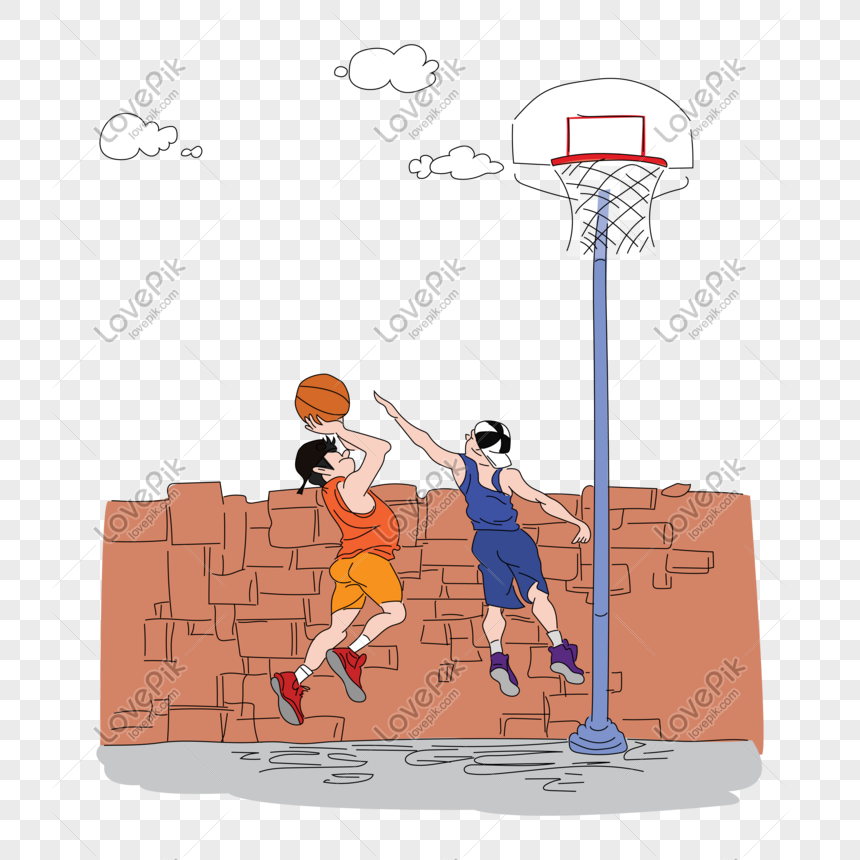 We shipped it out, and three days before the game, they put it down. Two days before the game they were certifying the floor and they called us and said the three-point line was 1 foot off. It was a brand-new arena, brand-new franchise. We were out there all night palm-sanding the three-point line off the floor. The finish dried hours before the game." We shipped it out, and three days before the game, they put it down. Two days before the game they were certifying the floor and they called us and said the three-point line was 1 foot off. It was a brand-new arena, brand-new franchise. We were out there all night palm-sanding the three-point line off the floor. The finish dried hours before the game." |
Tips: • Be sure images clients want reproduced aren't copyrighted. • Allow enough time for the whole project. • Give paint extra cure time. • Paint layers should be thin. |
| Eric Maxwell/AECOM Into the Woods When people think of current trends in out-of-the-box basketball floor designs, many immediately think of the University of Oregon floor unveiled in 2010, which features a forest of fir trees surrounding center court. Designed by Nike designer Tinker Hatfield, the graphics were executed by United Services Inc., and General Manager Shane Matheson recalls when he was first flown in to Eugene, Ore., to meet with all the Oregon big names to see an initial design: Designed by Nike designer Tinker Hatfield, the graphics were executed by United Services Inc., and General Manager Shane Matheson recalls when he was first flown in to Eugene, Ore., to meet with all the Oregon big names to see an initial design: "On the wall they had hung a mockup for the floor. They said, 'This is our floor; can you do this?' I started to laugh. They said, 'What are you laughing about?' I said, 'It's completely doable, but it's going to cost a ton of money. Get a dump truck and back it up to the bank.'" Matheson says it took them about a month and a half to figure out how to execute the design—one unlike anything seen before. Almost two miles of stencil materials were used to create it. "It was a fantastic experience for us, because we learned we could do things people said were impossible. You either really love that floor or hate it, and that was their marketing strategy all along." |
More photos of this United Services project:
Praters Athletic Flooring
'We really pushed the limits of what paints and sealers can do with this one,' says Praters' Mark Frainie of the 2016 Women's ACC Championship court.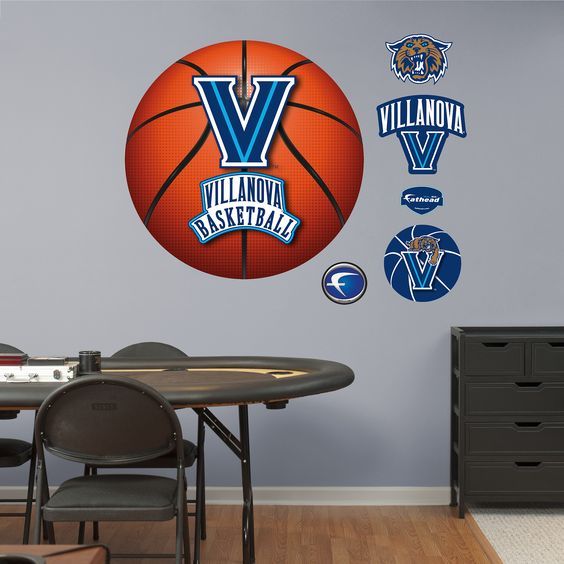
From its facility in Chattanooga, Tenn., Praters ships wild basketball floors all across the country. "Facilities don't get to sand their court down to bare wood very often. When they do, we encourage them to do something different, and we allow them to push the limits of court design by working with our design department. 'Whatever they want' is our attitude; let's make this particular facility a showplace," says President John Prater. "It doesn't matter whether it's the NCAA or a high school or the NBA, it's the same approach."
In the last couple years, the company has come to embrace the technique of using paint colors within their sealer coats, because the trend right now is for clients to want to see the grain of the floor. "That allows you to get any color of the rainbow, including colors that aren't traditional stain colors," Prater says. The technique also allows the company to match Pantone Matching System colors—a typical request for universities and schools particular about their branding—with the transparent look of a stain but without the need to use a traditional painted logo or other graphic.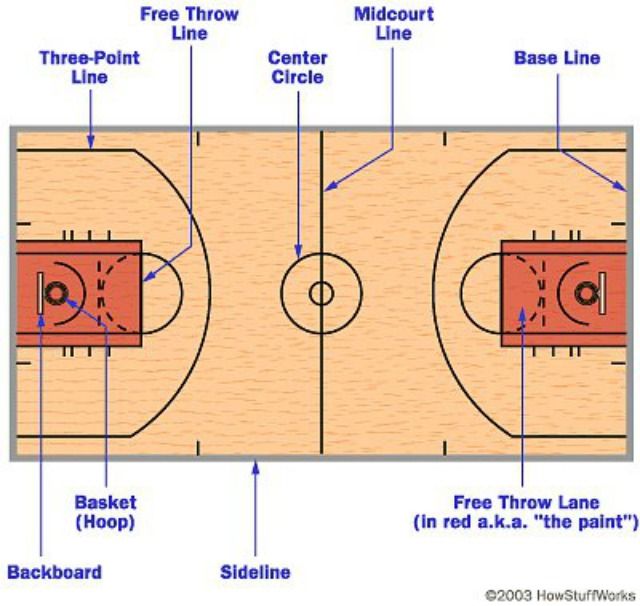 For earth tones, the company adds a concentrated dye in the sealer, and for other colors, paint is mixed with the sealer. "It gives us a lot more creative flexibility," Prater says.
For earth tones, the company adds a concentrated dye in the sealer, and for other colors, paint is mixed with the sealer. "It gives us a lot more creative flexibility," Prater says.
It does require more work in doing samples, however. Matching a PMS color with paint is straightforward since the paint is opaque. Matching a PMS color in a sealer requires lots of sampling and back and forth to get approval, since the color of the natural wood becomes a factor, and typically the colors used must be darker than the end color to compensate for the lightness of the maple.
There's a fallback when using pigments in sealers, too. "If it's absolutely horrible, I can always paint over it," Prater says. Because it doesn't penetrate the wood like a stain does, it tends to not bleed as much, and if the client ends up not liking it, you can "buzz it off with a sander real quick," he adds.
{rblink 2144}Either way, the technique is not a good one for a typical residential contractor to use since any areas with more or less finish show the color darker or lighter. It works on these types of jobs because there are no start or stop marks—the sealer application starts and stops on the masked area, or is simply pulled straight wall to wall.
It works on these types of jobs because there are no start or stop marks—the sealer application starts and stops on the masked area, or is simply pulled straight wall to wall.
No example of this technique shows it off better than the elaborate 2016 Women's ACC Championship court. The ACC had a good idea of what they wanted for their design; it features large geometric shapes, with blended blue, green and pink shades across the three-point areas, "as if they were painted by a giant artist's hand," says Praters Creative Director Mark Frainie. "We really pushed the limits of what paints and sealers can do with this one, as well as the techniques used for application," adding that when they first got the design concept, they weren't sure how they would achieve it.
The initial process for the new portable floor was typical: It was assembled in Praters' facility and sanded, then coated with two coats of sealer. Then three-point lines were striped, and three colors of pigmented sealer were applied using an 18-inch T-bar with a nylon foam pad. During application, the T-bar was treated "as if it were a huge paintbrush," and all the color was applied at one time—so there was only one shot to get the colors right. And it had to be done quickly to keep the product workable. It was not for the faint of heart, says Prater. After the pigmenting, the logos and lettering were applied, buffed and the final coat(s) were applied. "At the end of the day, the floor looked just like the picture—which is always nice!" Prater says.
During application, the T-bar was treated "as if it were a huge paintbrush," and all the color was applied at one time—so there was only one shot to get the colors right. And it had to be done quickly to keep the product workable. It was not for the faint of heart, says Prater. After the pigmenting, the logos and lettering were applied, buffed and the final coat(s) were applied. "At the end of the day, the floor looked just like the picture—which is always nice!" Prater says.
Tips: • Make sure everything you need is available on site, from tools to applicators. • Creating samples for customer approval is critical. • Experiment with new techniques on panels at your shop until you can get them down correctly. • Having a support team, from the office to on the floor, is critical to be able to pull off complicated designs. |
Training: For those interested in learning how to pull off complex basketball court designs, Praters doesn't keep its techniques a secret. In fact, its cool "The Edgegrain" blog on the company's website at pratersflooring.com has a series of "How it's Done" and "Tips & Tricks" videos showing how they do different techniques for their court designs. The company is also willing to act as a consultant. "We are partnering with more and more contractors around the country who are maybe hesitant to do a more complicated job. We provide anything from turnkey—we'll sand it and seal it and do the graphic application—to talking them through the design on the phone or sending one person out to the job to work on a project," John Prater says. In fact, its cool "The Edgegrain" blog on the company's website at pratersflooring.com has a series of "How it's Done" and "Tips & Tricks" videos showing how they do different techniques for their court designs. The company is also willing to act as a consultant. "We are partnering with more and more contractors around the country who are maybe hesitant to do a more complicated job. We provide anything from turnkey—we'll sand it and seal it and do the graphic application—to talking them through the design on the phone or sending one person out to the job to work on a project," John Prater says. |
Recent Creative Projects Ball Up Streetball:
"This is one of the most challenging designs we have worked on. The main court features five shades of gray and is designed to mimic the pattern on a heather-gray T-shirt. Coming up with a process to create this look consistently over the entire court took months to figure out and weeks to execute," says Praters Creative Director Mark Frainie.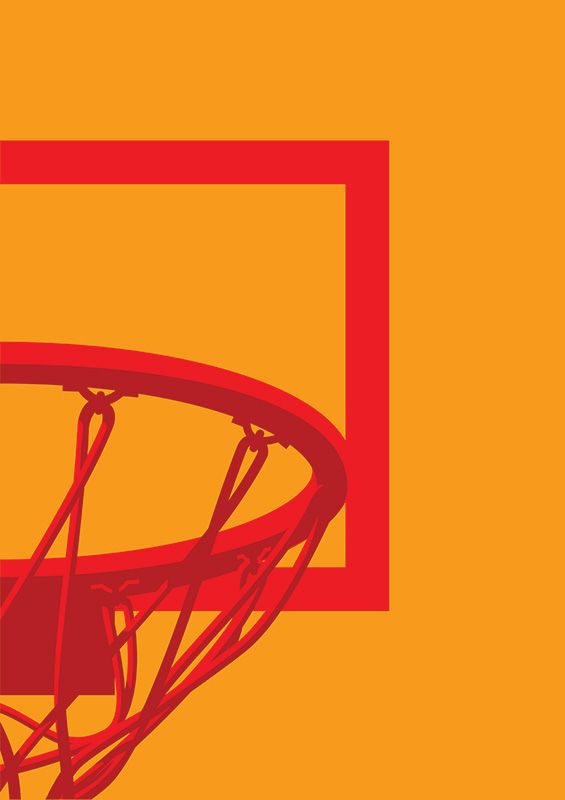 Abby Mitchell Texas Christian University: Praters worked with Ponder Company Inc. in Dallas to create this volleyball court. It and a matching basketball court are both based on TCU's frog-skin patterned uniforms. "There is so much detail that the task proved to be very labor-intensive and time-consuming," Frainie says. "The Ponder Company was able to allocate a tremendous amount of resources to this task, led by some really great and talented guys, to make quick work of it." Don Jedlovec, Santa Clara Athletics Santa Clara University:
Designed by Tinker Hatfield, the Nike designer who also created the University of Oregon court, the floor features the university's architecture. Praters coordinated with San Carlos, Calif.-based H.Y. Floor & Gameline Painting Inc. on the floor, employing paint in sealer coats for the architectural design. "The flooring professionals at H.Y. Floor made the process of installing the stencil and applying the various colors for the mission a breeze," Frainie says.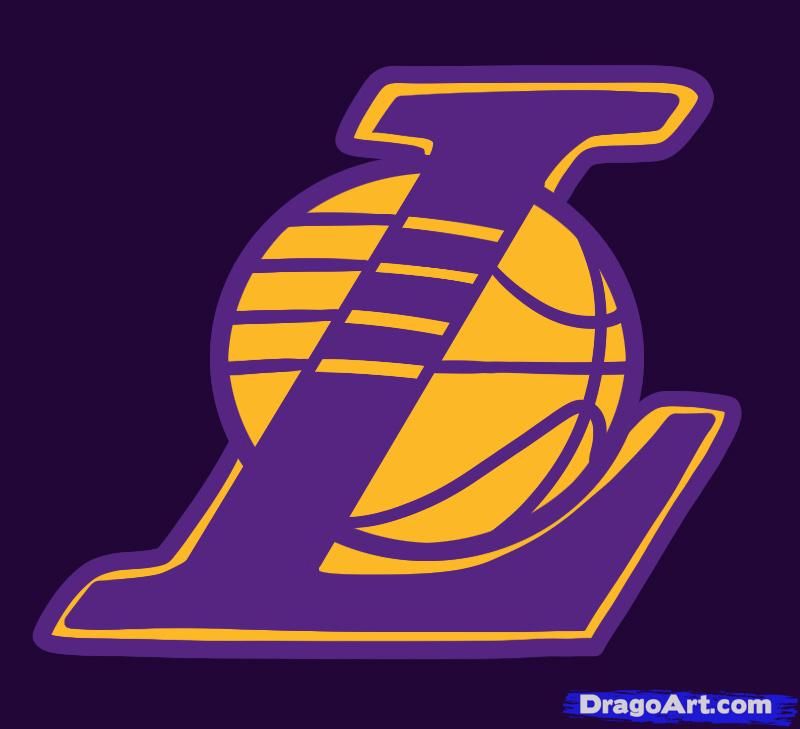 |
More photos from these Praters projects:
Sportstech Flooring
'You've just got to know what you're doing and be confident in what you're doing ... We've made mistakes; everybody does. It's part of the learning process,' says Andrew Ledford, project manager at Sportstech Flooring.
Complicated staining and dying jobs along with big graphics aren't just for NCAA and NBA floors. The trend has reached down to pre-collegiate levels, too, and companies like Sportstech Flooring in Tulsa, Okla., make their living specializing in gym floors in their region, handling all the design work, artwork and printing of stencils in-house. At Sportstech, "we probably do about 150 screen and coats per year and probably have 12 new floors going in this year," says Outside Salesperson Kathryn Gould.
The floor at Nathan Hale High School in Tulsa, Okla., (shown above) is a great example of how even high schools are taking a more modern approach with their basketball floors.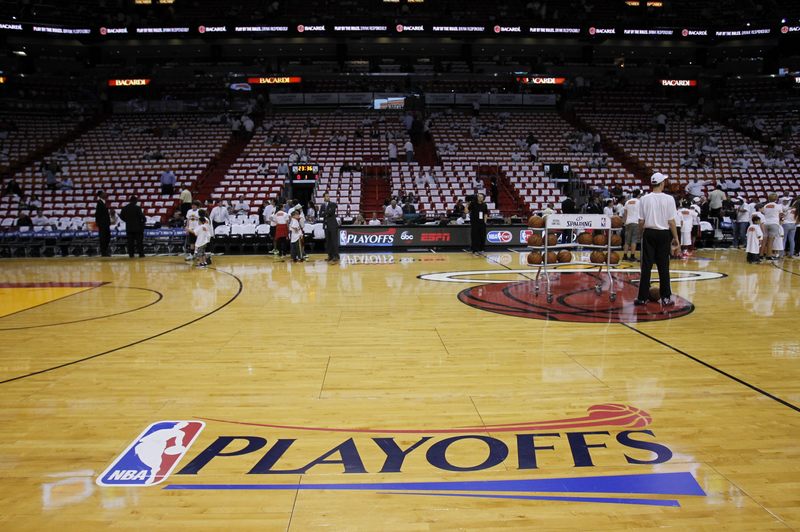 The fixed maple floor was sanded and screened, and tape was laid down for the lines for the lanes and three-point arc. The lanes and basketball circles were premasked to leave only the three-point arc exposed. A white stain was mixed with sealer and applied to the three-point arc with a T-bar. After at least four hours of dry time, they peeled up the premasks in the key and premasked everything around the basketball circles, then coated those with sealer with a brown tint. The next day they peeled everything up, ran a maroon pad over all of it to knock down the grain and sealed the entire floor with two coats of sealer without any color.
The fixed maple floor was sanded and screened, and tape was laid down for the lines for the lanes and three-point arc. The lanes and basketball circles were premasked to leave only the three-point arc exposed. A white stain was mixed with sealer and applied to the three-point arc with a T-bar. After at least four hours of dry time, they peeled up the premasks in the key and premasked everything around the basketball circles, then coated those with sealer with a brown tint. The next day they peeled everything up, ran a maroon pad over all of it to knock down the grain and sealed the entire floor with two coats of sealer without any color.
Once the seal coats were dry, the floor was screened because "paint has to have something to stick to," says Sportstech Project Manager Andrew Ledford. This logo was relatively easy, he says, because it was only white and gray. "Whenever we do a stencil, painting the outline is first, and then we just work different colors one at a time," he explains.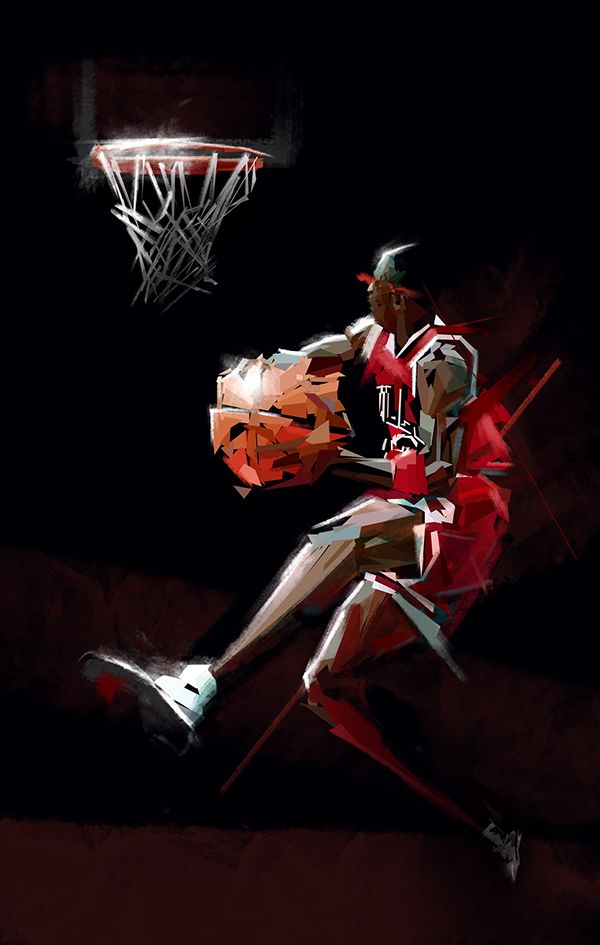 So the white was painted, and, once dry, the areas were cut out for the gray paint. Each color had at least two coats of paint. "After it's all set, you pull all the premask up and you have a single logo," Ledford says.
So the white was painted, and, once dry, the areas were cut out for the gray paint. Each color had at least two coats of paint. "After it's all set, you pull all the premask up and you have a single logo," Ledford says.
"If you don't do it a lot, it's easy to get lost in a logo," Ledford says. "You might pull the wrong color. If you're using paint, it's easier, because you can repaint with the right color. If it's stain, you're done for and you have to resand." Once the logo and lines were painted, the entire floor was abraded and the topcoats are applied for a completed floor.
Ledford says he is happy to see the trend toward using stains and tints that show the grain in the wood. "A while ago, every customer thought the more paint they had on the floor, the better it looked," he says. "But paint just sits on top, and you have to worry about scuff marks."
Tips: • Follow directions about how much color you can add to the sealer to avoid peeling. • Sealer coats with color must be applied carefully but fast enough that they don't start to set up and tear. • Be prepared to do multiple coats of paint, particularly for some colors. |
The Sports Authority When it comes to maple sports flooring, the Maple Flooring Manufacturers Association Inc. is the authority. Formed in 1897, the MFMA publishes northern hard maple/beech/birch grade standards and floor care recommendations, and its PUR Standards use ASTM standards to define acceptability for shock absorption, vertical deflection, area of deflection, ball bounce and, for finishes, surface friction. Complete info on MFMA can be found at maplefloor.org. |
See the Basketball Courts of the Top 12 Seeded Teams in March Madness
March 16, 2022
How Do They Put Temporary Logos On Basketball Courts?
How do they put temporary logos on basketball courts?
The stencils are carefully adhered to the gym floor and have layers, so when one paint area is dry, a section can be removed and another area painted. … “We put the base paint layers down, pull the vinyl up, then take transfer paper—what they use on top of vinyl—and put that on top of it and cut it,” Matheson explains.
… “We put the base paint layers down, pull the vinyl up, then take transfer paper—what they use on top of vinyl—and put that on top of it and cut it,” Matheson explains.
Amazingly, how often do they paint NBA courts? Below that oil- or water-based final finish, which is reapplied every off-season, as per NBA rules, also comes plenty of paint, with center-court logos averaging 300 square feet in the NBA and city names or nicknames adorning the baselines, along with arena names, the NBA logo and secondary logos.
In regards to, are the logos on the NBA court real? “Throughout the postseason, the logo will appear on pole pads and seat backs, and on digital LED stanchions and courtside signage. With this added exposure for playoffs branding, we determined the logos on the court were unnecessary.”
In this regard, are NBA courts painted? NBA floor specifications require a 120 feet x 60 feet (36.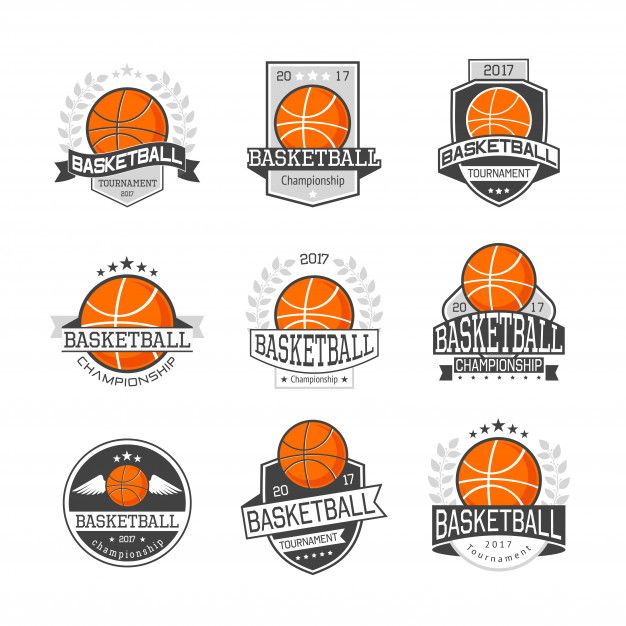 6 x 18.3 meters) wood surface with a 94 feet x 50 feet (28.7 x 15.2 meters) painted basketball court. This is typically produced in smaller interlocking sections that can be expertly put together to ensure a perfect finish.
6 x 18.3 meters) wood surface with a 94 feet x 50 feet (28.7 x 15.2 meters) painted basketball court. This is typically produced in smaller interlocking sections that can be expertly put together to ensure a perfect finish.
Also, how is an NBA floor made? The standard NBA floor is made from acer saccharum, also known as hard maple. This specific variety is harder than most hardwoods and lighter in color. To turn these trees into a playable surface, the NBA employs three companies, Horner, Robbins, and Connor Sports Flooring.
Contents
- What do they use on basketball floors?
- Do they wax basketball courts?
- How much does a NBA basketball court cost?
- What kind of wood is basketball floor?
- Are the NBA bubble courts smaller?
- Why is Jordan logo on pelicans court?
- Are NBA courts different?
- What’s under a basketball court?
- How do they build basketball courts?
- What color was the first basketball?
What do they use on basketball floors?
Today’s professional basketball courts vary widely in their design, subflooring systems and staining, but two things are (almost) always the same: the hardwood used to make them and the polyurethane used as a finish.
Do they wax basketball courts?
If you noticed that in professional basketball courts, you will see a team constantly cleaning the floors that is left by sweat by the players. The reason they do this is because their floor is highly polished in which case the slip factor is at such a level in which water may cause it to become slippery once again.
How much does a NBA basketball court cost?
A full NBA-standard court will cost you $46,000 to construct it. A half-court will cost you $23,000. As the court’s dimensions decrease, so does the total price. That’s quite clear because putting up a court with highschool dimensions will cost you $43,000 for a full-court and $21,000 for a half-court.
What kind of wood is basketball floor?
The maple floor also turned out to be the perfect surface for dribbling a basketball. Gymnasium floors, and indoor basketball courts as an extension, have continued to be made of hard maple.
Are the NBA bubble courts smaller?
The three “broadcast courts” in the bubble measure 120′ by 68′, 8 inches wider than standard.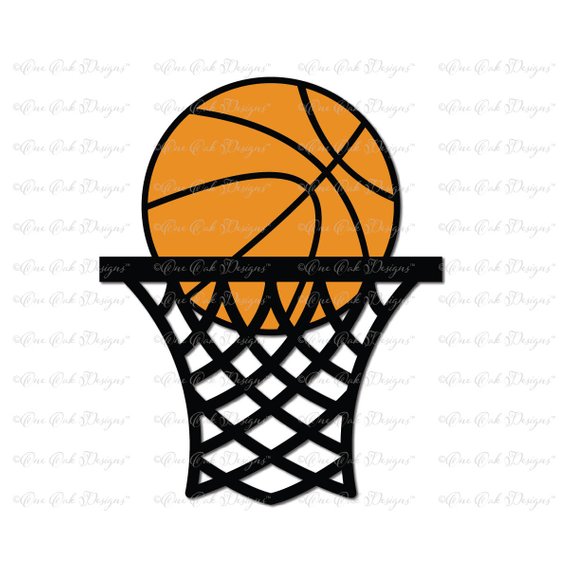 Even with no courtside seats, this protracted floor puts an additional four feet between the playing surface and the plexiglass that separates scorer’s table, media and broadcast crew members.
Even with no courtside seats, this protracted floor puts an additional four feet between the playing surface and the plexiglass that separates scorer’s table, media and broadcast crew members.
Why is Jordan logo on pelicans court?
“Each season, the Statement Edition designs set the tone for key matchups and are inspired by NBA teams making a bold statement every time they step onto the court — a natural connection to Jordan Brand’s namesake and his approach to the game,” Nike said in a statement.
Are NBA courts different?
Basketball courts come in many different sizes. In the National Basketball Association (NBA), the court is 94 by 50 feet (28.7 by 15.2 m). Under International Basketball Federation (FIBA) rules, the court is slightly smaller, measuring 28 by 15 meters (91.9 by 49.2 ft). In amateur basketball, court sizes vary widely.
What’s under a basketball court?
One of the most common types of subflooring systems used today for gymnasiums incorporates round rubber pads under a plywood subfloor. The pads are small rubber discs filled with air, set about 12 inches (30.5 centimeters) apart from each other over the entire area of the floor.
The pads are small rubber discs filled with air, set about 12 inches (30.5 centimeters) apart from each other over the entire area of the floor.
How do they build basketball courts?
When it’s time to convert an ice hockey rink to a basketball court, the walls and glass panels around the rink are removed. Then large pieces of insulated plywood are laid out over the top of the ice. Finally the basketball court is pieced together like a puzzle on top of the plywood.
What color was the first basketball?
The first basketball was dark-brown in color due to its heavy leather construction. Even though design-changes were so common in the 20th century, color-changes were not seen until 1957.
Basketball court markings: standards and norms
Author of the article
Khvatkov Dmitry
Consultant in the production of rubber coatings
Basketball field marking requirements are approved by the FIBA standard. The site must be flat with a hard surface, free of bends, cracks and other obstacles.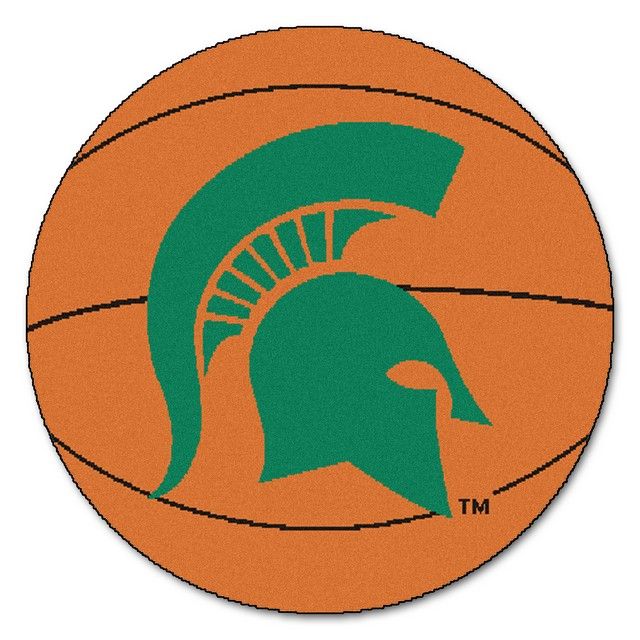 The accepted dimensions of the field are 28 m long and 16 m wide. By NBA standards, the field is slightly larger: 28.7 m (94' ft) long and 15.3 m (50' ft) wide.
The accepted dimensions of the field are 28 m long and 16 m wide. By NBA standards, the field is slightly larger: 28.7 m (94' ft) long and 15.3 m (50' ft) wide.
Areas not intended for international competitions may differ from accepted standards (for public use, in schools or universities, etc.) and usually vary from 20 to 28 m in length and from 12 to 16 m in width.
Basketball Court Marking Standards
Basketball court markings are conventionally divided into 5 components:
- Boundary lines. They are located along the perimeter of the site and set its size. The lines that run along the field are called side lines, and those that are behind the baskets are called front lines.
- Central line. Divides the court in half parallel to the front lines.
- Central zone. It is a circle and is placed in the middle of the center line, and, accordingly, in the center of the entire field.
- Three-point line. It is a semi-ellipse and is located around the shields on both sides of the field.
 It limits the close range.
It limits the close range. - Free throw line. It is located in front of the boards parallel to the front line and is limited on the sides by paint lines.
The standard line width is 5 cm. All outlines and lines must be of the same color (usually white) and be clearly visible from anywhere on the court.
Common lines
Common lines are used to limit the playing area of the court. The side lines (along the field) according to FIBA standards should be 28 m long, and the front lines - 16 m. For public areas, deviations from the accepted standards are allowed. Typically, basketball courts in schools or gyms are made from 20 m long and 12 m wide.
Central lines
The center line is parallel to the front and divides the field exactly in half. According to the standards - it should extend beyond the side lines by 15 cm on both sides.
In the middle of the center line there is a circle with a diameter of 3.6 m, which limits the central zone of the field. In this zone, the ball is played at the beginning of the game.
In this zone, the ball is played at the beginning of the game.
Three-point line
Three-point lines are located around the backboards on both sides of the field and consist of two straight lines with a length of 2.99 m and a semicircle. Straight lines run perpendicular to the front at a distance of 0.9 m from the side lines. Despite the fact that visually the distance from the ring to the side of the three-point line seems to be less than to its central part, the distance from the backboard to any point is 6.75 m.
Penalty lines
Penalty lines limit the nearest area at the backboard. They consist of a trapezoid and a free throw zone.
Despite the name, the "trapezium" is a rectangle (until 2009year it really was a trapezoid), which is located under the shield. Its dimensions are 5.8 meters long and 4.9 meters wide. The shield is located at a distance of 1.575 m from the end line in the middle of the court. In front of the backboard, at a distance of 1. 25 m, there is a semicircle that limits the area for picking up the ball.
25 m, there is a semicircle that limits the area for picking up the ball.
At a distance of 4.225 meters from the backboard, the trapeze zone ends and the free throw zone begins. It is a semicircle with a diameter of 3.6 m (like the central circle).
Paint zone lines
These lines are serifs on both sides of the trapezoid (parallel to the sidelines). They limit the areas for players who are fighting for the ball during a free throw.
Zones on the basketball field
The basketball court is divided into zones using markings. Each zone has its own specific rules.
Center circle
The center circle is used as a separate kick-off area at the start of the game. One representative from each team stand in a circle from their side and fight for the ball in a jump, after it is dropped by the referee. All players are exclusively on their side of the field, except for one who rebounds on the opponent's side.
Neutral zone
The peculiarity of this zone is that as soon as the player of the attacking team with the ball crosses the center line and is on the side of the opponent, he cannot pass the ball to the player of his team who is on the other side of the field (i.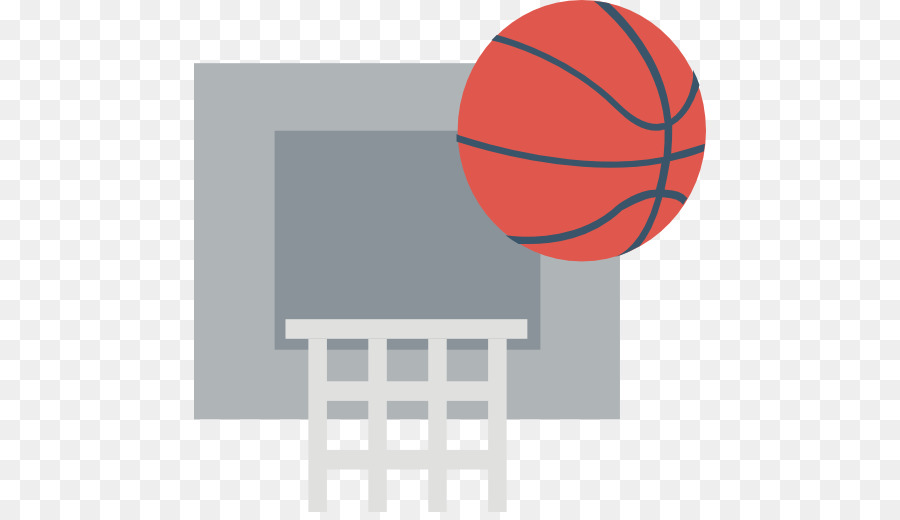 e. behind center line on your side).
e. behind center line on your side).
Three-point zone
The three-point line limits the near zone of the shot. Hitting the basket from outside the basket brings the team three points. If the throw was made inside the zone, then it brings two points.
Three-second zone
This is the zone in close proximity to the ring. It is called three-second, since the player of the attacking team cannot be in it for more than three seconds. Most balls are thrown in this zone, so when attacking, it provides maximum protection.
Free throw area
In controversial situations, a free throw is provided from this area. The player of the attacking team must score the ball without stepping over the line of the trapezoid. At the same time, the players of both teams are not in the three-second zone. They take up positions along the paint lines on the sides of the trapezoid and may not step outside the lines until the free throw shooter has shot the ball.
How to mark a basketball field?
Basketball field markings, whether it is an international competition court or an open-air amateur field, are best applied using special equipment.![]() This will ensure the long life of the coating, the lines will not clog and will promote fair play.
This will ensure the long life of the coating, the lines will not clog and will promote fair play.
You can order the marking of a basketball court in Moscow and the Moscow region from Rezkom. We will measure the premises and develop a design project for the field so that it complies with generally accepted rules and is convenient for operation. For more details, you can contact our manager by phone 8-495-64-24-111.
Gym marking - Rezcom
Author of the article
Khvatkov Dmitry
Consultant in the production of rubber coatings
Safety floor coverings made of painted rubber crumb are successfully used for arranging indoor gyms and playgrounds intended for playing volleyball, mini-football, badminton, basketball, handball. The final stage of the installation of the anti-slip coating is the implementation of a standardized marking of the playing area.
All lines must be performed in strict accordance with the current regulations, which are established by the international federations of the respective sports. The gym area itself should be flat, the surface should be hard and uniform. Any unevenness in the form of protruding parts, depressions, cracks, etc. not allowed.
The gym area itself should be flat, the surface should be hard and uniform. Any unevenness in the form of protruding parts, depressions, cracks, etc. not allowed.
What paint is used
If a special multi-colored marking tape on a self-adhesive basis can be used to mark the floors of sports halls on linoleum, then in the case of rubber seamless floors, 2-component polyurethane compounds of foreign production are used. Such paints are prepared in compliance with the technology by mixing the two components immediately before application.
Unlike one-component paints, polyurethane coatings remain plastic even after complete drying, therefore they do not peel off when the rubber base is deformed.
The two-component composition has excellent adhesion, the paint fits well and is fixed monolithically over a long period of intensive use of the site. The marking made with polyurethane paint does not fade and is not erased under significant loads. The paint is safe, because after a few hours after complete drying, the solvent and other toxic products do not remain in the composition.
When zoning a playing field with a rubber coating, it is possible to use integrated markings using pigmented (colored) rubber crumb.
Features of marking the playing field
The coloring composition has a dense structure, which avoids smudges. Subject to the application technology, the lines are smooth and clear. The main colors for drawing borders are white, light gray, yellow, red and blue.
Often, when arranging a gym on one sports ground, markings are applied simultaneously for different sports, for example, for football and basketball. In such cases, to avoid confusion, a 2-component paint of the same composition is used, but in different colors.
Since the composition based on polyurethane polymerizes quickly, the paint is stirred in a small amount that can be used up within two hours. The optimum air temperature for working with paint is 18-25 degrees, humidity is not more than 65%. Painting is carried out after careful preparation of the base, cleaning and drying of the surface of the site.
The lines are applied in accordance with the scheme, manually using a special roller. If the lines are long and the delivery time of the object is limited, then specialized marking machines are often used for marking.
In an open area, work on creating field boundaries is carried out in clear weather. Application of the coating on a damp substrate is not permitted. For embossed surfaces, the contours of future lines should be pre-glued to prevent paint from flowing beyond the borders.
Gym marking requirements
- All lines must stand out against the main background. More often, white or light gray paint is used to decorate school gyms.
- The boundaries must be clearly visible from anywhere on the playing field.
- The width of the marking lines when creating a playing field for volleyball, handball, basketball should be 50 mm, for badminton - 40 mm, for mini-football - 80 mm.
- Marking lines are subjected to intense mechanical stress during operation, so the paint must be wear-resistant.

- Sites for official events must be marked according to the standards; for small school and amateur gyms, scaling the marking down is allowed.
- At the stage of designing a sports field, it should be taken into account that for most sports it is necessary to provide an auxiliary space outside the main field of the playing field.
Sports markings
For each sport, there are agreed standards for the dimensions of the playing field, the color and width of the markings, approved by the relevant sports federations. School gyms are often too small for standard markings - in this case, they resort to scaling, i.e. to reduce the format in proportion to the size of the hall.
Volleyball
The requirements for the arrangement of the volleyball field are approved by the standard of the International Volleyball Federation (FIVB). The standard dimensions of a volleyball field are as follows: length - 18 m, width - 9 m.
Basketball
The requirements for the organization of a basketball court in an indoor gym are approved by the standard of the International Basketball Federation.